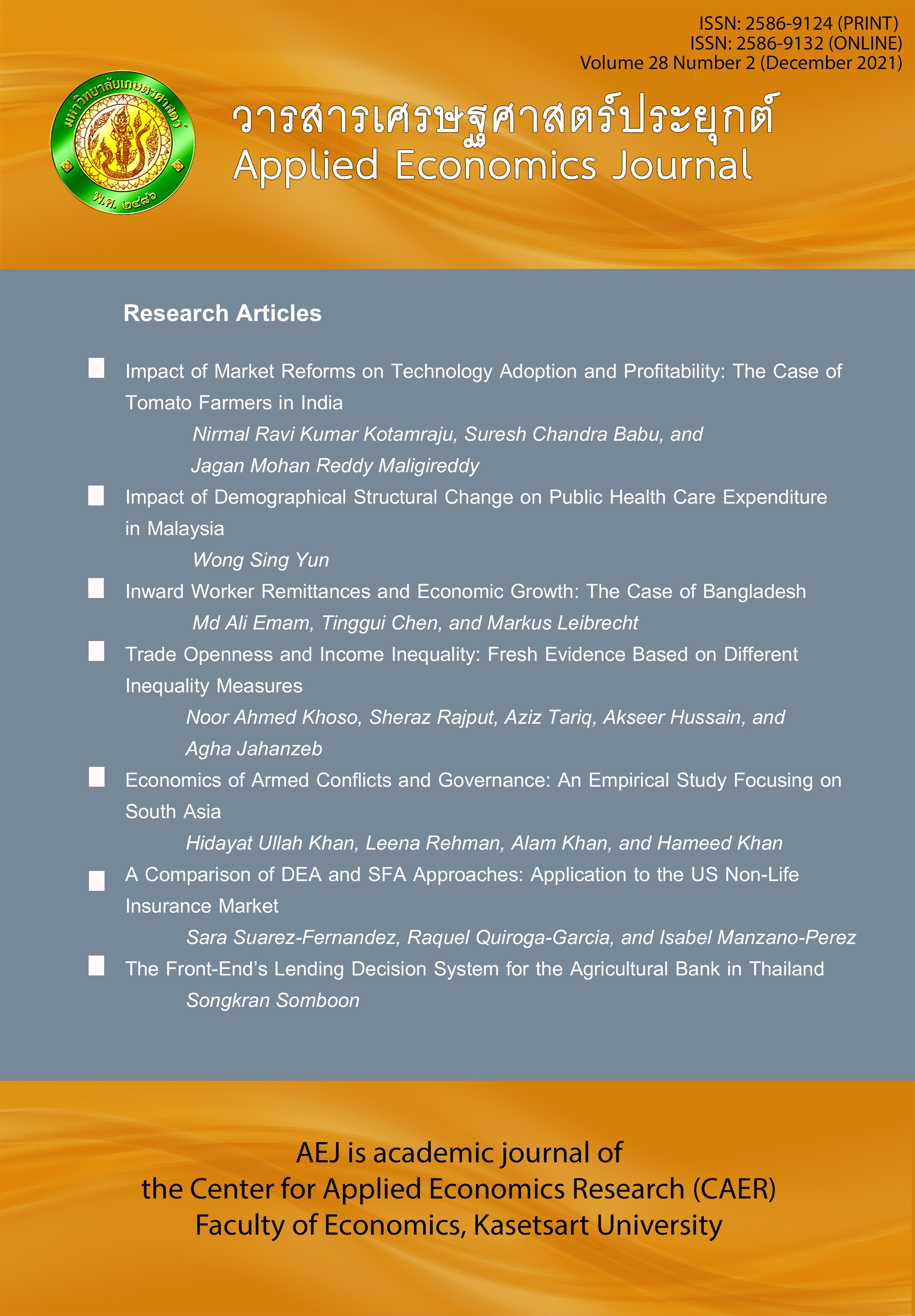Trade Openness and Income Inequality: Fresh Evidence Based on Different Inequality Measures
Main Article Content
Abstract
Theoretical and empirical literature on the impact of trade openness on income inequality is inconclusive. The inconsistent findings may be partly the result of biased measures of income inequality and divergent data sources. This paper improves upon the previous literature by examining the impact of trade openness on income inequality, using data from three major data sources: the Standardized World Income Inequality Database (SWIID), including disposable and market income; World Development Indicators (WDI); and the University of Texas Inequality Project (UTIP); as well as four Gini coefficients as measures of inequality. We apply a two-step system GMM estimation technique and the findings suggest a negative relationship between trade openness and income inequality. Based on the empirical results, we conclude that changing the measure of inequality from different data sources does not affect the empirical results related to the trade-inequality relationship.
Article Details
The paper is published under CC BY-NC-ND, in which the article is freely downloaded and shared in its original form non-commercially and its citation details are identified.
References
Acar, S., & Dogruel, F. (2012). Sources of inequality in selected MENA countries. Structural Change and Economic Dynamics, 23(3), 276-285.
Asteriou, D., Dimelis, S., & Moudatsou, A. (2014). Globalization and income inequality: A panel data econometric approach for the EU27 countries. Economic Modelling, 36, 592-599.
Barro, R. J. (2000). Inequality and growth in a panel of countries. Journal of Economic Growth, 5(1), 5-32.
Barro, R. J. (2008). Inequality and growth revisited (ADB Working Paper Series on Regional Economic Integration No. 11). Manila: Asian Development Bank.
Bergh, A., & Nilsson, T. (2010). Do liberalization and globalization increase income inequality? European Journal of Political Economy, 26(4), 488-505.
Bond, S. R., Hoeffler, A., & Temple, J. R. (2001). GMM estimation of empirical growth models (Economics Papers 2001-W21). Oxford: Nuffield College, University of Oxford.
Deininger, K., & Squire, L. (1996). A new data set measuring income inequality. The World Bank Economic Review, 10(3), 565-591.
Feenstra, R. C., & Hanson, G. H. (1996). Globalization, outsourcing, and wage inequality. American Economic Review, 86(2), 240-245.
Galbraith, J. K., Choi, J., Halbach, B., Malinowska, A., & Zhang, W. (2016). A comparison of major world inequality data sets: LIS, OECD, EU-SILC, WDI, and EHII. In L. Cappellari, S. W. Polachek, & K. Tatsiramos (Eds.), Income Inequality Around the World (pp. 1-48). West Yorkshire: Emerald Group Publishing Limited.
Harrison, A., McLaren, J., & McMillan, M. S. (2010). Recent findings on trade and inequality (NBER Working Paper No. w16425). Massachusetts: National Bureau of Economic Research.
Heimberger, P. (2020). Does economic globalisation affect income inequality? A meta-analysis. The World Economy, 43(11), 2960-2982.
Im, K. S., Pesaran, M. H., & Shin, Y. (2003). Testing for unit roots in heterogeneous panels. Journal of Econometrics, 115(1), 53-74.
Jaumotte, F., Lall, S., & Papageorgiou, C. (2013). Rising income inequality: Technology, or trade and financial globalization? IMF Economic Review, 61(2), 271-309.
Knutsen, C. H. (2015). Reinvestigating the reciprocal relationship between democracy and income inequality. Review of Economics and Institutions, 6(2), 1-37.
Krugman, P. R., & Obstfeld, M. (2009). International economics: Theory and policy. London: Pearson.
Labra, R., & Torrecillas, C. (2018). Estimating dynamic Panel data. A practical approach to perform long panels. Revista Colombiana de Estadística, 41(1), 31-52.
Lin, F., & Fu, D. (2016). Trade, institution quality and income inequality. World Development, 77, 129-142.
Lundberg, M., & Squire, L. (2003). The simultaneous evolution of growth and inequality. The Economic Journal, 113(487), 326-344.
O'Rourke, K. H. (2002). Globalization and inequality: Historical trends. Aussenwirtschaft, University of St. Gallen, School of Economics and Political Science, Swiss Institute for International Economics and Applied Economics Research, 57(1), 65-104.
Ravallion, M. (2018). Inequality and globalization: A review essay. Journal of Economic Literature, 56(2), 620-42.
Roodman, D. (2009). How to do xtabond2: An introduction to difference and system GMM in Stata. The Stata Journal, 9(1), 86-136.
Smeeding, T., & Latner, J. P. (2015). PovcalNet, WDI and ‘All the Ginis’: a critical review. The Journal of Economic Inequality, 13(4), 603-628.
Solt, F. (2016). The standardized world income inequality database. Social Science Quarterly, 97(5), 1267-1281.
Spilimbergo, A., Londoño, J. L., & Székely, M. (1999). Income distribution, factor endowments, and trade openness. Journal of Development Economics, 59(1), 77-101.
Todaro, M. P., & Smith, S. C. (2015). Economic development. London: Pearson.
Zhou, L., Biswas, B., Bowles, T., & Saunders, P. J. (2011). Impact of globalization on income distribution inequality in 60 countries. Global Economy Journal, 11(1), 1850216.


